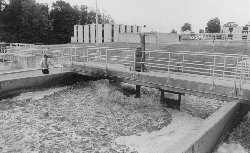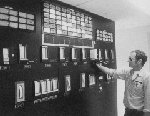In 1966, Kentucky and Indiana water pollution officials declared "Four Freedoms" for the Ohio River under the Water Quality Act of 1965: "Freedom from flotsam; freedom from poison; freedom from stench; freedom from sludge." These freedoms were accompanied by stringent new wastewater standards that brought protests from most of the major local industries. The costs of the cleanup would be tremendous.
At a public hearing on the new standards in December, 1966, Morris Forman said the Fort Southworth plant would have to add secondary treatment facilities, at a cost of $10 million to $20 million, to meet the proposed standards.
In September, 1967 MSD announced plans to build the secondary treatment facilities; by July of 1969 the cost estimate had reached $25 million. Less than a year later, the cost estimate reached $46 million — about $15 million of which would come from federal funds. The estimates kept rising; MSD spent $2 million for design, and when the major construction contract was awarded in early 1972, the winning bid was for more than $55 million.
By late 1972, the total cost of the unfinished project was estimated at about $62 million; the federal government would pay more than $34 million.
The Hite Creek Plant
In 1967 Jefferson County attracted its largest new industrial project since General Electric’s Appliance Park: the new Ford truck assembly plant in eastern Jefferson County.
The plant required a heavy investment in public infrastructure, including the extension of Jefferson Freeway from Interstate 71 to Westport Road, and a new sewage treatment plant to serve the factory and its surrounding suburbs.
The money for the $2.1 million plant was found quickly: more than $800,000 from the federal government, $600,000 from Ford, and the rest from Jefferson County government.
The Hite Creek plant opened in late 1970 — a state-of-the-art treatment plant that discharged water that was "safe enough to drink." MSD legend says that one of the consulting engineers would actually take a few sips of the treated wastewater to emphasize the point.
The plant won several design and operation awards in its early years, and would continue to win awards through the 1990s. It was destined to provide outstanding wastewater treatment for a growing suburban area.


MSD Photos by Martin E. Biemer
Countywide Expansion
Despite quick action on the Hite Creek plant, action on the 1964 master plan for countywide sewers lagged. The main reason was a continuing lack of money. The cost of constructing the Fort Southworth secondary treatment facilities was daunting, and MSD didn’t have the money for large-scale construction of trunk sewers and other plants. Eugene A. McSweeney, chairman of the MSD Board at the time, summed up the situation in a 1967 interview with The Courier-Journal: "It’s just fantastic to think the city and county fathers would hand us $100 million — but basically, that’s just what’s needed."
Action was so slow that in 1969, the proposed site for the North County treatment plant was rezoned for Louisville’s Edith Avenue landfill — which would become an environmental problem itself a generation later.
There was some progress, however. A 1968 state law made it possible for MSD to expand by assessing property owners a share of the costs of providing them with new sewers. This eliminated the need to form sewer sub-districts, a very cumbersome process.
In 1967, the Louisville Water Company absorbed the Middletown Water District, including three small sewer systems; it turned the sewer systems over to MSD. In 1970, MSD dissolved the Middletown sewer sub-district and converted the expansion into an assessment project.
And in 1968, after years of discussion, MSD began installing sewer lines in Avondale and Brookhaven, the last major areas of the City of Louisville without sewers. The projects were completed within two years. (Septic tanks remained in a few small areas of the city, and MSD would find itself occasionally building sewers to fill in these miscellaneous "left out" areas for the next 30 years.)
Urban Renewal
Urban renewal brought massive changes to the downtown area in the late 1960s — including the first major effort to separate the city’s sanitary and storm sewers. In late 1968, the combined cost of the street and sewer improvements in the urban renewal area was estimated at $18 million — most to be paid by the federal government, but much left to local governments.
The 13th Street project, which started in 1971, is an example: MSD spent about $1 million to separate storm and sanitary sewers in the stretch from Broadway to Market Street; the federal government paid about $2.6 million.
Throughout the Urban Renewal area, storm sewers would be separated from sanitary sewers. But when the new sewer lines reached the edge of the projects, they were reconnected to the old combined sewer system.
MSD History continued


